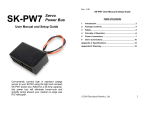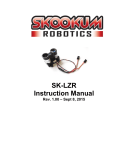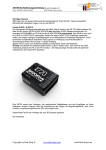Download SK720 Flybarless System - User Manual
Transcript
Rev 3.00 SK-PW7 User Manual & Setup Guide SK-PW7 Servo Power Bus User Manual and Setup Guide Table of Contents 1 Introduction..............................................................................4 2 Package Contents....................................................................5 3 Safety........................................................................................6 4 Principle of Operation .............................................................7 5 Connections.............................................................................8 5.1 Satellite Receiver with High Voltage Servos....................11 5.2 Satellite Receiver with Some 5V Servos...........................12 5.3 Traditional Receiver with High Voltage Servos ...............13 5.4 Traditional Receiver with Some 5V Servos ......................14 Appendix A: Specifications ..........................................................15 Appendix B: Signal Bus Connections Schematic .......................15 Appendix C: Warranty...................................................................16 Conveniently connect high or standard voltage servos to your SK720 using the light and compact SK-PW7 power bus. Rated for a 20-Amp capacity, this power bus will eliminate brown-outs and simplify wiring aboard your medium to large size R/C helicopter. And with the new Advanced Power Bus, you can switch your helicopter’s electronics on and off simply by connecting/disconnecting a jumper plug. ©2011 Skookum Robotics, Ltd 2 List of Figures 1 Figure 1 – SK-PW7....................................................................... 7 Figure 2 – SK720 Connected to SK-PW7 ................................... 8 Figure 3 – Schematic of SK720 Connections to SK-PW7 ......... 9 Figure 4 – SK-PW7 Power Rails Schematic ............................. 10 Figure 5 – Typical Installation with High Voltage Servos and Satellite Receiver ............................................. 11 Figure 6 – Typical Installation with Satellite Receiver and some 5V Servos ................................................ 12 Introduction The SK-PW7 servo power bus is a compact and light solution for your servo wiring needs. Intended for use on medium and large size radio controlled helicopters, it allows connection of an SK720 digital flybar to your high voltage (8.4-Volt, typical) servos. The rated 20-Amp capacity will also help eliminate brownouts. And the power bus even offers the flexibility to use a combination of high and standard voltage servos on your radio-controlled helicopter while maintaining a tidy wiring installation. The new Advanced Power Bus also contains a soft switch to enable you to turn your helicopter’s electronics on and off simply by connecting / disconnecting a jumper plug. Figure 7 – Typical Traditional Receiver Instillation with HV Servos......................................................... 13 Figure 8 – Typical Traditional Receiver Instillation with Some 5V servos ............................................... 14 ©2011 Skookum Robotics, Ltd 3 ©2011 Skookum Robotics, Ltd 4 2 3 Package Contents The SK-PW7 servo power bus does not include a fuse or voltage regulator. Install switches, fuses and / or a BEC (as required for your installation) into your circuit per standard practices. Ideally, check all electrical connections using a multi-meter prior to connecting the power bus to any voltage source. Your servo power bus package includes: • • Safety SK-PW7 Servo Power Bus Four servo cable jumpers Do not exceed 20-Amps continuous current on either the Advanced Power Bus or the standard Power Bus. WARNING: The Term “High Voltage” is used in this manual to differentiate 8.4-Volt servo systems from the standard 5-Volt servo systems. Do not connect the SK-PW7 servo power bus to any supply voltage higher than 10 Volts. ©2011 Skookum Robotics, Ltd 5 ©2011 Skookum Robotics, Ltd 6 4 Principle of Operation 5 The SK-PW7 servo power bus is designed to provide the power required for your high voltage servos by letting you attach them directly to a 2S 8.4V LiPo battery. The device contains two separate “power rails” one of which may be connected to a 5 Volt supply (such as a BEC or standard 4-cell NiCd battery), while the other is connected directly to the 8.4V battery. This allows you to use both high and low voltage servos at the same time. Connections The SK-PW7 has twelve servo plug sockets on the front face. Notice that the labels on this face are the same as those on the SK720’s servo connections? You can connect your servos to the sockets on the power bus just as you would connect them to the SK720. The back face of the SK-PW7 has four servo plug sockets and two 18-gauge silicone wires. The four servo plug sockets on this face of the SK-PW7 power bus are used to connect the SK-PW7 to the SK720 as shown in Figure 2 and Figure 3 of this manual. The Advanced power bus has a yellow-red wire extending from the back of the case. The jumper connected to the plug at the end of this wire controls the Advanced power bus’ built-in soft-switch. Figure 1 – SK-PW7 The Advanced power bus contains a soft-switch that turns the SK-PW7’s highvoltage rail on and off. The switch is activated by removing a jumper plug connected to the plug on the end of the yellow-red wires that extend from the back of the unit. The power bus can also be used to power your SK720. When properly connected, the SK720 will be powered off the PWR-HV power rail. The SK720 is rated for up to 10V, so a single 8.4-Volt, 2-Cell LiPo battery will be sufficient to power both your SK720 and your high voltage servos. ©2011 Skookum Robotics, Ltd 7 Figure 2 – SK720 Connected to SK-PW7 You will need to solder a suitable connector (i.e. a Dean’s connector) to the 18-gauge silicone wires before you can connect the SK-PW7 power bus to your battery. ©2011 Skookum Robotics, Ltd 8 Have a close look at Figure 3 below. It shows a schematic view of the wiring shown in Figure 2. Can you see that the servo jumper wires connected to BUS-B and BUS-C should be aligned horizontally across the top of the SK720? Figure 4 – SK-PW7 Power Rails Schematic The 36-pin front face includes two power rails (labelled in orange in Figure 4, above). The high voltage (8.4-Volt) rail is labelled PWR-HV while the low voltage (5-Volt) rail is marked as PWR-LV. Figure 3 – Schematic of SK720 Connections to SK-PW7 The PWR-HV rail is powered directly by the two 18-gauge silicone wires fitted to the back of the unit. The PWR-LV rail is not powered unless it is connected to the PWR-HV rail by means of a jumper or to a separate voltage source such as a battery or BEC. WARNING: the SK-PW7 servo power bus does not include a switch, fuse or voltage regulator. These must be installed separately, as required for your installation. ©2011 Skookum Robotics, Ltd 9 ©2011 Skookum Robotics, Ltd 10 5.1 Satellite Receiver with High Voltage Servos 5.2 The schematic in Figure 5 below illustrates a typical installation of a system that uses high voltage servos and a satellite receiver. Satellite Receiver with Some 5V Servos The schematic in Figure 6 below shows a typical instillation of a system with a satellite receiver that uses some low voltage servos. Figure 5 – Typical Installation with High Voltage Servos and Satellite Receiver In this case the throttle servo is supplied with 8.4 V by means of a jumper that connects the high and low voltage rails. The whole system (including the SK720) is supplied with 8.4 V from the 2S 8.4V LiPo battery connected to the 18-gauge silicone wires. Figure 6 – Typical Installation with Satellite Receiver and some 5V Servos In this example, the throttle servo is supplied with 5.0 V by means of a BEC connected across the PWR-HV and PWR-LV sockets. Servos connected to the IO-B, IO-D and IO-E sockets will also be supplied with 5.0 V from the BEC when your SK-PW7 power bus is set up this way. The rest of the system (including the SK720) is supplied with 8.4 V from the 2S LiPo battery that is connected to the 18-gauge silicone wires. The socket marked TAIL is a special case. The SK-PW7 Power Bus has one socket for the tail servo on the PWR-HV side and one on the PWR-LV side. This gives you the flexibility to use either a high voltage tail servo or a 5V tail servo together with your high voltage swash servos. ©2011 Skookum Robotics, Ltd 11 ©2011 Skookum Robotics, Ltd 12 5.3 Traditional Receiver with High Voltage Servos 5.4 Traditional Receiver with Some 5V Servos You can also use the SK-PW7 power bus with a traditional receiver. Figure 8 – Typical Traditional Receiver Installation with Some 5V servos Figure 7 – Typical Traditional Receiver Installation with HV Servos If you are using a traditional receiver with your SK720 (i.e. you’re not using satellite receivers), then servo ports IO-A through IO-D are not available. In this case, only connect jumpers BUS-A and BUS-B. You will then need to connect servo wire jumpers from the SK720’s ports IO-A through Ext-LED to your traditional receiver, as shown in Figure 7, above. In this case, the whole system (including the SK720 and traditional receiver) is supplied with 8.4 V from the 2S LiPo battery connected to the 18-gauge silicone wires. CAUTION: A traditional receiver connected as shown in Figure 7 will receive 8.4V. Be sure your receiver can handle that amount of voltage if you wire it this way. If you are using a traditional receiver with your SK720, then servo ports IO-A through IO-D are not available. In this case, only connect jumpers BUS-A and BUS-B. You will then need to connect servo wire jumpers from the SK720’s ports IO-A through Ext-LED to your traditional receiver, as shown in Figure 8 above. The socket marked TAIL is a special case. The SK-PW7 Power Bus has one socket for the tail servo on the PWR-HV side and one on the PWR-LV side. This gives you the flexibility to use either a high voltage tail servo or a 5V tail servo together with your high voltage swash servos. In this example, the tail servo is supplied with 5V by a BEC connected between the PWR-HV and PWR-LV sockets. The BEC is supplied with 8.4V from the PWR-HV connection. The BEC’s 5V output is connected to the PWR-LV socket. CAUTION: A traditional receiver connected as shown in Figure 8 will receive 8.4V. Be sure your receiver can handle that amount of voltage if you wire it this way. ©2011 Skookum Robotics, Ltd 13 ©2011 Skookum Robotics, Ltd 14 Appendix C: Warranty Appendix A: Specifications Warranty and Repair: Dimensions Weight (without cables) Operating Temperature Range Operating Voltage Maximum Power Rating 39mm x 24mm x 15mm 16 grams -10°C to +45°C 3.6 to 10 VDC 20 Amp Skookum Robotics Ltd warrants this product against any defects in materials or workmanship for a period of 90 days from the purchase date. This warranty is limited to the original purchaser. In the event of a malfunction, Skookum Robotics will repair or replace the product to meet its standard operating condition. This warranty does not apply in cases where the product has been overheated, electrically shorted, subject to crash damage, otherwise abused, or had unauthorized repair attempts. UNDER NO CIRCUMSTANCES DOES SKOOKUM ROBOTICS ACCEPT LIABILITY FOR INCIDENTAL DAMAGE OR INJURIES RESULTING FROM THE OPERATION OF THE SK-PW7 POWER BUS OR OTHER PRODUCTS. Appendix B: Signal Bus Connections Schematic Skookum Robotics will provide customers with technical assistance by email free of charge. If a unit’s serviceability is in question following a crash, we will check it over for only the cost of postage. If the unit has malfunctioned and the 90-day warranty period has expired, we will attempt repair and discuss the cost of possible repairs with the owner, again for only the cost of postage. If you wish to return the SK-PW7 power bus, please write “WARRANTY RETURN” clearly on the shipping box and mail it to the address given below. Manufactured in Canada by Skookum Robotics, Ltd ©2011 Skookum Robotics, Ltd 15 Email: Website: [email protected] www.skookumrobotics.com Return Mail: PO Box 46912 Stn D Vancouver, BC V6J 5M4 Canada ©2011 Skookum Robotics, Ltd 16
















